Citroen C3 PICASSO 2012 1.G Owner's Manual
Manufacturer: CITROEN, Model Year: 2012, Model line: C3 PICASSO, Model: Citroen C3 PICASSO 2012 1.GPages: 244, PDF Size: 8.21 MB
Page 101 of 244
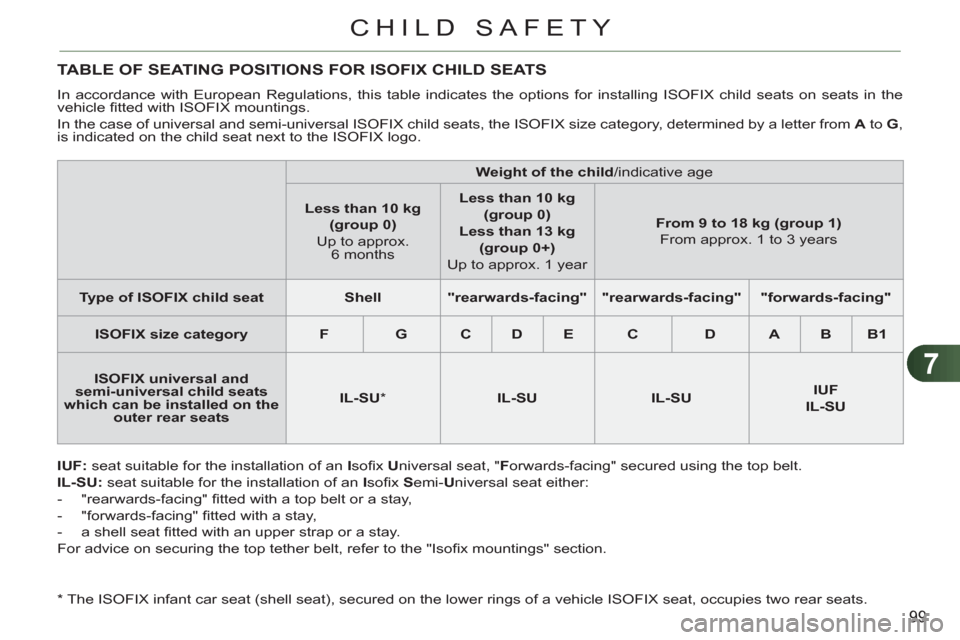
7
99
CHILD SAFETY
TABLE OF SEATING POSITIONS FOR ISOFIX CHILD SEATS
In accordance with European Regulations, this table indicates the options for installing ISOFIX child seats on seats in the
vehicle fi tted with ISOFIX mountings.
In the case of universal and semi-universal ISOFIX child seats, the ISOFIX size category, determined by a letter from A
to G
,
is indicated on the child seat next to the ISOFIX logo.
IUF:
seat suitable for the installation of an I
sofi x U
niversal seat, " F
orwards-facing" secured using the top belt.
IL-SU:
seat suitable for the installation of an I
sofi x S
emi- U
niversal seat either:
- "rearwards-facing" fi tted with a top belt or a stay,
- "forwards-facing" fi tted with a stay,
- a shell seat fi tted with an upper strap or a stay.
For advice on securing the top tether belt, refer to the "Isofi x mountings" section.
* The ISOFIX infant car seat (shell seat), secured on the lower rings of a vehicle ISOFIX seat, occupies two rear seats.
Weight of the child
/indicative age
Less than 10 kg
(group 0)
Up to approx.
6 months
Less than 10 kg
(group 0)
Less than 13 kg
(group 0+)
Up to approx. 1 year
From 9 to 18 kg (group 1)
From approx. 1 to 3 years
Type of ISOFIX child seat
Shell
"rearwards-facing"
"rearwards-facing"
"forwards-facing"
ISOFIX size category
F
G
C
D
E
C
D
A
B
B1
ISOFIX universal and
semi-universal child seats
which can be installed on the
outer
rear
seats
IL-SU
*
IL-SU
IL-SU
IUF
IL-SU
Page 102 of 244

7
100
CHILD SAFETY
This system is independent and
in no circumstances does it take
the place of the central locking
system.
Check the status of the child lock
each time you switch on the ignition.
Always remove the key from the
ignition when leaving the vehicle,
even for a short time.
In the event of a serious impact,
the electric child lock is deacti-
vated automatically to permit the
exit of the rear passengers.
MANUAL CHILD LOCK
Mechanical system to prevent opening
of the rear door using its interior control.
The control is located on the edge of
each rear door.
�)
Insert the ignition key in the red
control.
�)
Turn in the direction indicated by the
arrow marked on the door.
ELECTRIC CHILD LOCK
Control system to prevent opening of the
rear doors using their interior controls and
use of the rear electric windows.
The control is located on the driver's
door, with the electric window controls.
�)
Press button A
.
The indicator lamp in button A
comes
on, accompanied by a message in the
multifunction screen.
This indicator lamp remains on until the
child lock is deactivated.
Locking
Unlocking
�)
Insert the ignition key in the red
control.
�)
Turn in the opposition direction to
the arrow marked on the door.
Locking
Unlocking
�)
Press button A
again.
The indicator lamp in button A
goes off,
accompanied by a message in the mul-
tifunction screen.
This indicator lamp remains off until the
child lock is activated.
Any other status of the indica-
tor lamp indicates a malfunction
of the electric child lock. Have it
checked by a CITROËN dealer
or a qualifi ed workshop.
The activation of the function is con-
fi rmed by the temporary illumination
of this warning lamp in the translu-
cent digital instrument panel.
Page 103 of 244
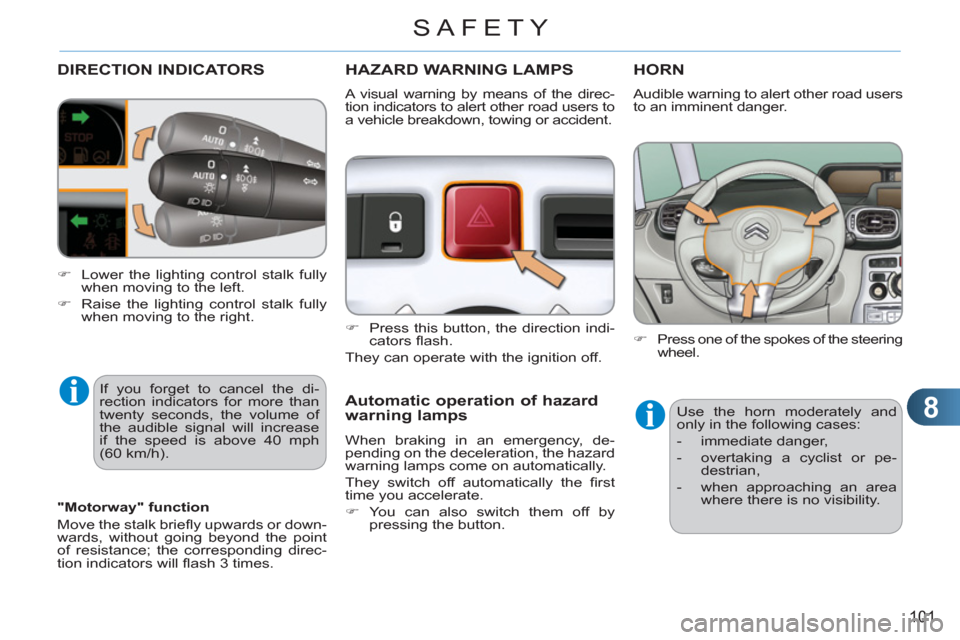
8
101
SAFETY
DIRECTION INDICATORS
If you forget to cancel the di-
rection indicators for more than
twenty seconds, the volume of
the audible signal will increase
if the speed is above 40 mph
(60 km/h).
HAZARD WARNING LAMPS
�)
Press this button, the direction indi-
cators fl ash.
They can operate with the ignition off.
Automatic operation of hazard
warning lamps
When braking in an emergency, de-
pending on the deceleration, the hazard
warning lamps come on automatically.
They switch off automatically the fi rst
time you accelerate.
�)
You can also switch them off by
pressing the button.
HORN
�)
Press one of the spokes of the steering
wheel.
Use the horn moderately and
only in the following cases:
- immediate danger,
- overtaking a cyclist or pe-
destrian,
- when approaching an area
where there is no visibility.
Audible warning to alert other road users
to an imminent danger.
"Motorway" function
Move the stalk briefl y upwards or down-
wards, without going beyond the point
of resistance; the corresponding direc-
tion indicators will fl ash 3 times.
A visual warning by means of the direc-
tion indicators to alert other road users to
a vehicle breakdown, towing or accident.
�)
Lower the lighting control stalk fully
when moving to the left.
�)
Raise the lighting control stalk fully
when moving to the right.
Page 104 of 244
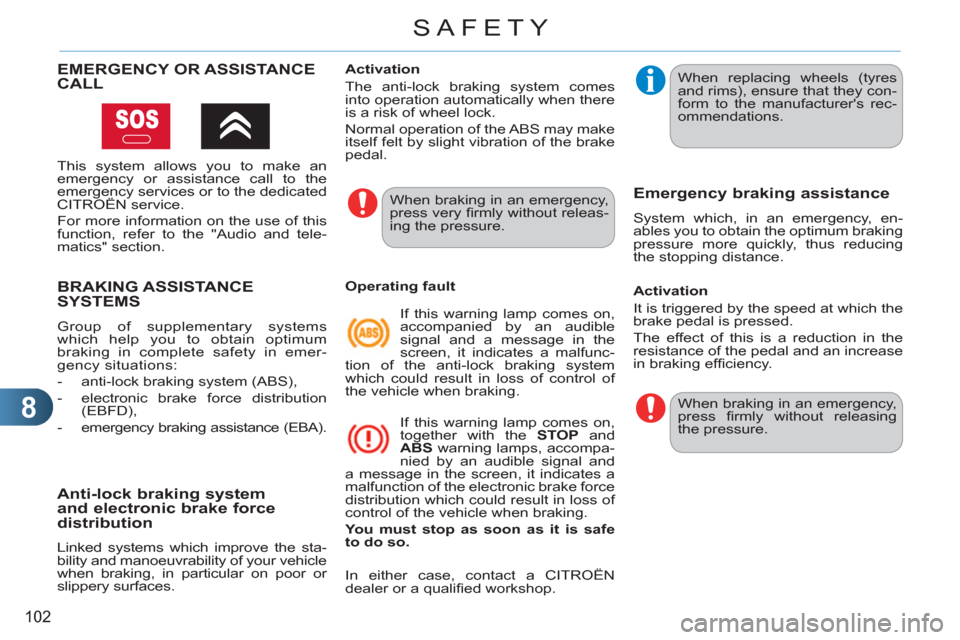
8
102
SAFETY
BRAKING ASSISTANCE
SYSTEMS
Group of supplementary systems
which help you to obtain optimum
braking in complete safety in emer-
gency situations:
- anti-lock braking system (ABS),
- electronic brake force distribution
(EBFD),
- emergency braking assistance (EBA).
Anti-lock braking systemand electronic brake force
distribution
Linked systems which improve the sta-
bility and manoeuvrability of your vehicle
when braking, in particular on poor or
slippery surfaces.
When braking in an emergency,
press very fi rmly without releas-
ing the pressure.
When replacing wheels (tyres
and rims), ensure that they con-
form to the manufacturer's rec-
ommendations.
Operating fault
If this warning lamp comes on,
accompanied by an audible
signal and a message in the
screen, it indicates a malfunc-
tion of the anti-lock braking system
which could result in loss of control of
the vehicle when braking.
If this warning lamp comes on,
together with the STOP
and
ABS
warning lamps, accompa-
nied by an audible signal and
a message in the screen, it indicates a
malfunction of the electronic brake force
distribution which could result in loss of
control of the vehicle when braking.
You must stop as soon as it is safe
to do so.
Emergency braking assistance
System which, in an emergency, en-
ables you to obtain the optimum braking
pressure more quickly, thus reducing
the stopping distance.
Activation
The anti-lock braking system comes
into operation automatically when there
is a risk of wheel lock.
Normal operation of the ABS may make
itself felt by slight vibration of the brake
pedal.
Activation
It is triggered by the speed at which the
brake pedal is pressed.
The effect of this is a reduction in the
resistance of the pedal and an increase
in braking effi ciency.
In either case, contact a CITROËN
dealer or a qualifi ed workshop. When braking in an emergency,
press fi rmly without releasing
the pressure.
EMERGENCY OR ASSISTANCE
CALL
This system allows you to make an
emergency or assistance call to the
emergency services or to the dedicated
CITROËN service.
For more information on the use of this
function, refer to the "Audio and tele-
matics" section.
Page 105 of 244
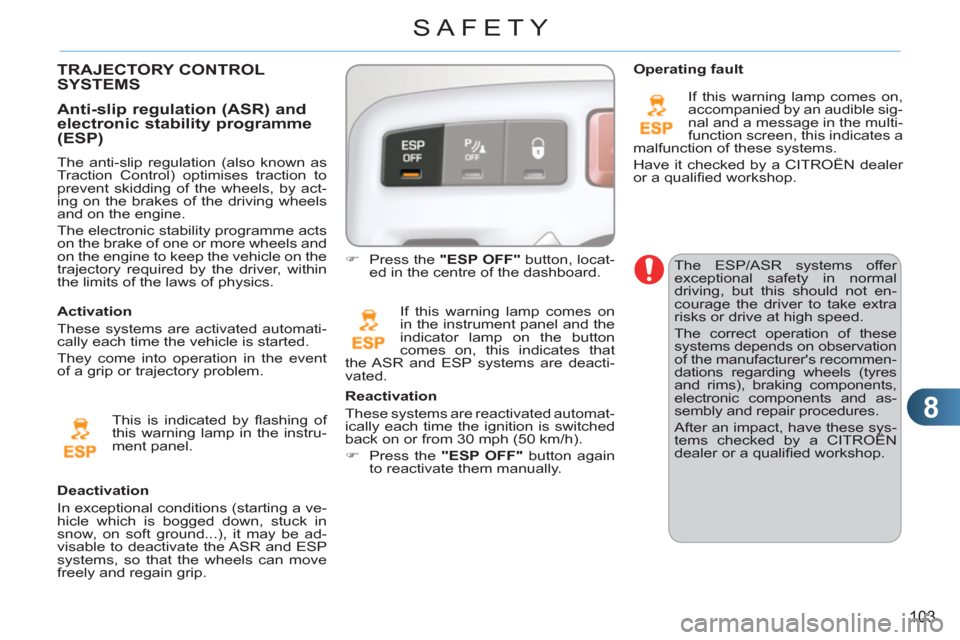
8
103
SAFETY
The ESP/ASR systems offer
exceptional safety in normal
driving, but this should not en-
courage the driver to take extra
risks or drive at high speed.
The correct operation of these
systems depends on observation
of the manufacturer's recommen-
dations regarding wheels (tyres
and rims), braking components,
electronic components and as-
sembly and repair procedures.
After an impact, have these sys-
tems checked by a CITROËN
dealer or a qualifi ed workshop.
Deactivation
In exceptional conditions (starting a ve-
hicle which is bogged down, stuck in
snow, on soft ground...), it may be ad-
visable to deactivate the ASR and ESP
systems, so that the wheels can move
freely and regain grip.
�)
Press the "ESP OFF"
button, locat-
ed in the centre of the dashboard.
If this warning lamp comes on
in the instrument panel and the
indicator lamp on the button
comes on, this indicates that
the ASR and ESP systems are deacti-
vated.
Reactivation
These systems are reactivated automat-
ically each time the ignition is switched
back on or from 30 mph (50 km/h).
�)
Press the "ESP OFF"
button again
to reactivate them manually.
Operating fault
If this warning lamp comes on,
accompanied by an audible sig-
nal and a message in the multi-
function screen, this indicates a
malfunction of these systems.
Have it checked by a CITROËN dealer
or a qualifi ed workshop.
TRAJECTORY CONTROLSYSTEMS
The anti-slip regulation (also known as
Traction Control) optimises traction to
prevent skidding of the wheels, by act-
ing on the brakes of the driving wheels
and on the engine.
The electronic stability programme acts
on the brake of one or more wheels and
on the engine to keep the vehicle on the
trajectory required by the driver, within
the limits of the laws of physics.
Anti-slip regulation (ASR) and
electronic stability programme (ESP)
This is indicated by fl ashing of
this warning lamp in the instru-
ment panel.
Activation
These systems are activated automati-
cally each time the vehicle is started.
They come into operation in the event
of a grip or trajectory problem.
Page 106 of 244
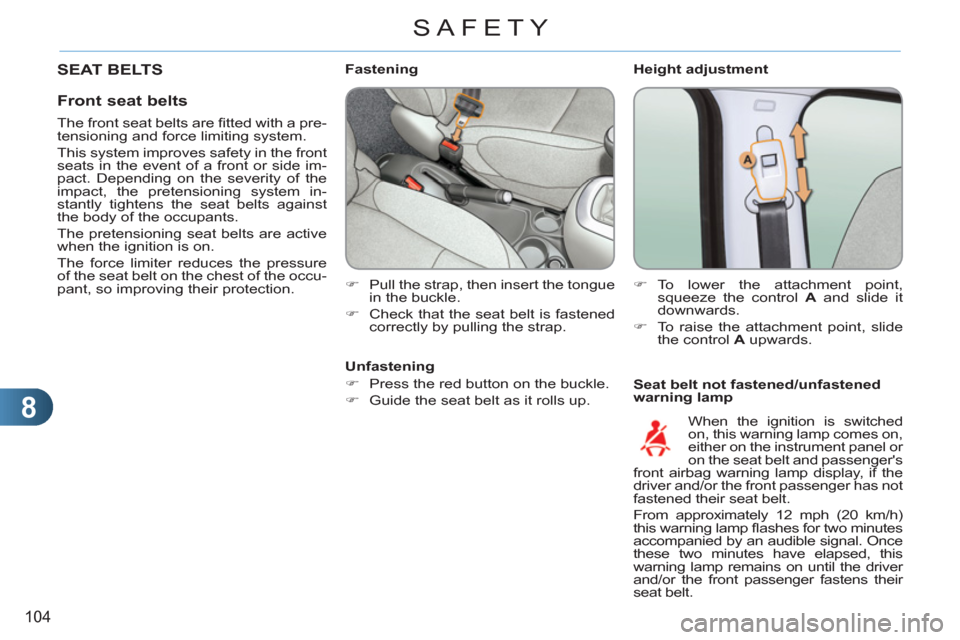
8
104
SAFETY
Height adjustment
Seat belt not fastened/unfastened
warning lamp
Fastening
�)
Pull the strap, then insert the tongue
in the buckle.
�)
Check that the seat belt is fastened
correctly by pulling the strap.
�)
To lower the attachment point,
squeeze the control A
and slide it
downwards.
�)
To raise the attachment point, slide
the control A
upwards.
When the ignition is switched
on, this warning lamp comes on,
either on the instrument panel or
on the seat belt and passenger's
front airbag warning lamp display, if the
driver and/or the front passenger has not
fastened their seat belt.
From approximately 12 mph (20 km/h)
this warning lamp fl ashes for two minutes
accompanied by an audible signal. Once
these two minutes have elapsed, this
warning lamp remains on until the driver
and/or the front passenger fastens their
seat belt.
Unfastening
�)
Press the red button on the buckle.
�)
Guide the seat belt as it rolls up.
SEAT BELTS
Front seat belts
The front seat belts are fi tted with a pre-
tensioning and force limiting system.
This system improves safety in the front
seats in the event of a front or side im-
pact. Depending on the severity of the
impact, the pretensioning system in-
stantly tightens the seat belts against
the body of the occupants.
The pretensioning seat belts are active
when the ignition is on.
The force limiter reduces the pressure
of the seat belt on the chest of the occu-
pant, so improving their protection.
Page 107 of 244
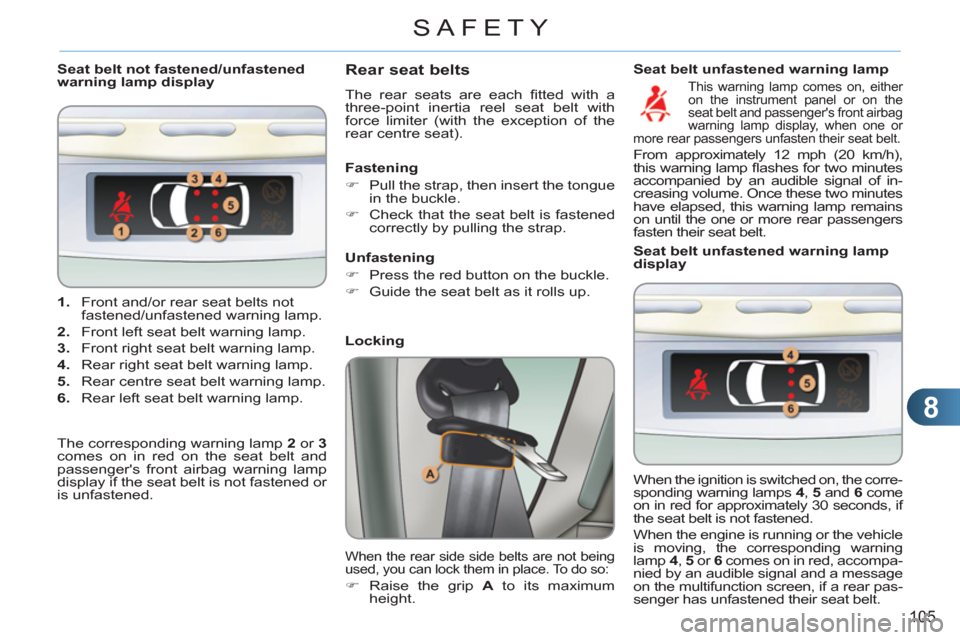
8
105
SAFETY
1.
Front and/or rear seat belts not
fastened/unfastened warning lamp.
2.
Front left seat belt warning lamp.
3.
Front right seat belt warning lamp.
4.
Rear right seat belt warning lamp.
5.
Rear centre seat belt warning lamp.
6.
Rear left seat belt warning lamp.
Seat belt not fastened/unfastened
warning lamp display
Rear seat belts
The rear seats are each fi tted with a
three-point inertia reel seat belt with
force limiter (with the exception of the
rear centre seat).
Locking
When the rear side side belts are not being
used, you can lock them in place. To do so:
�)
Raise the grip A
to its maximum
height.
Fastening
�)
Pull the strap, then insert the tongue
in the buckle.
�)
Check that the seat belt is fastened
correctly by pulling the strap.
Seat belt unfastened warning lamp
display
When the ignition is switched on, the corre-
sponding warning lamps 4
, 5
and 6
come
on in red for approximately 30 seconds, if
the seat belt is not fastened.
When the engine is running or the vehicle
is moving, the corresponding warning
lamp 4
, 5
or 6
comes on in red, accompa-
nied by an audible signal and a message
on the multifunction screen, if a rear pas-
senger has unfastened their seat belt.
Unfastening
�)
Press the red button on the buckle.
�)
Guide the seat belt as it rolls up.
The corresponding warning lamp 2
or 3
comes on in red on the seat belt and
passenger's front airbag warning lamp
display if the seat belt is not fastened or
is unfastened.
Seat belt unfastened warning lamp
This warning lamp comes on, either
on the instrument panel or on the
seat belt and passenger's front airbag
warning lamp display, when one or
more rear passengers unfasten their seat belt.
From approximately 12 mph (20 km/h),
this warning lamp fl ashes for two minutes
accompanied by an audible signal of in-
creasing volume. Once these two minutes
have elapsed, this warning lamp remains
on until the one or more rear passengers
fasten their seat belt.
Page 108 of 244

8
SAFETY
2 nd row rear centre seat belt
Installation
Removal and storing
�)
Press the red button on the buckle B
,
then on the buckle A
.
�)
Guide the strap as it rolls up and
bring the tongue B
, then A
onto the
magnet of the attachment point on
the roof.
�)
Pull the strap and insert the tongue A
in the left-hand buckle.
�)
Insert the tongue B
in the right-hand
buckle.
�)
Check the fastening of each buckle
by pulling the strap.
The seat belt for the rear centre seat of
the 2 nd row is incorporated at the rear
left of the roof.
Page 109 of 244
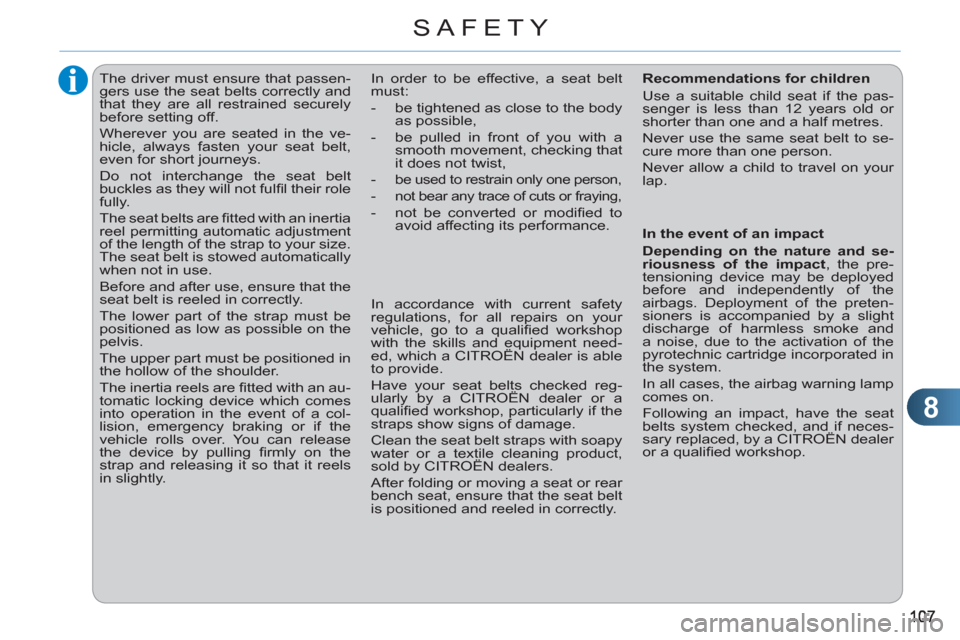
8
SAFETY
The driver must ensure that passen-
gers use the seat belts correctly and
that they are all restrained securely
before setting off.
Wherever you are seated in the ve-
hicle, always fasten your seat belt,
even for short journeys.
Do not interchange the seat belt
buckles as they will not fulfi l their role
fully.
The seat belts are fi tted with an inertia
reel permitting automatic adjustment
of the length of the strap to your size.
The seat belt is stowed automatically
when not in use.
Before and after use, ensure that the
seat belt is reeled in correctly.
The lower part of the strap must be
positioned as low as possible on the
pelvis.
The upper part must be positioned in
the hollow of the shoulder.
The inertia reels are fi tted with an au-
tomatic locking device which comes
into operation in the event of a col-
lision, emergency braking or if the
vehicle rolls over. You can release
the device by pulling fi rmly on the
strap and releasing it so that it reels
in slightly. In order to be effective, a seat belt
must:
- be tightened as close to the body
as possible,
- be pulled in front of you with a
smooth movement, checking that
it does not twist,
-
be used to restrain only one person,
- not bear any trace of cuts or fraying,
- not be converted or modifi ed to
avoid affecting its performance.
In accordance with current safety
regulations, for all repairs on your
vehicle, go to a qualifi ed workshop
with the skills and equipment need-
ed, which a CITROËN dealer is able
to provide.
Have your seat belts checked reg-
ularly by a CITROËN dealer or a
qualifi ed workshop, particularly if the
straps show signs of damage.
Clean the seat belt straps with soapy
water or a textile cleaning product,
sold by CITROËN dealers.
After folding or moving a seat or rear
bench seat, ensure that the seat belt
is positioned and reeled in correctly.
Recommendations for children
Use a suitable child seat if the pas-
senger is less than 12 years old or
shorter than one and a half metres.
Never use the same seat belt to se-
cure more than one person.
Never allow a child to travel on your
lap.
In the event of an impact
Depending on the nature and se-
riousness of the impact
, the pre-
tensioning device may be deployed
before and independently of the
airbags. Deployment of the preten-
sioners is accompanied by a slight
discharge of harmless smoke and
a noise, due to the activation of the
pyrotechnic cartridge incorporated in
the system.
In all cases, the airbag warning lamp
comes on.
Following an impact, have the seat
belts system checked, and if neces-
sary replaced, by a CITROËN dealer
or a qualifi ed workshop.
Page 110 of 244
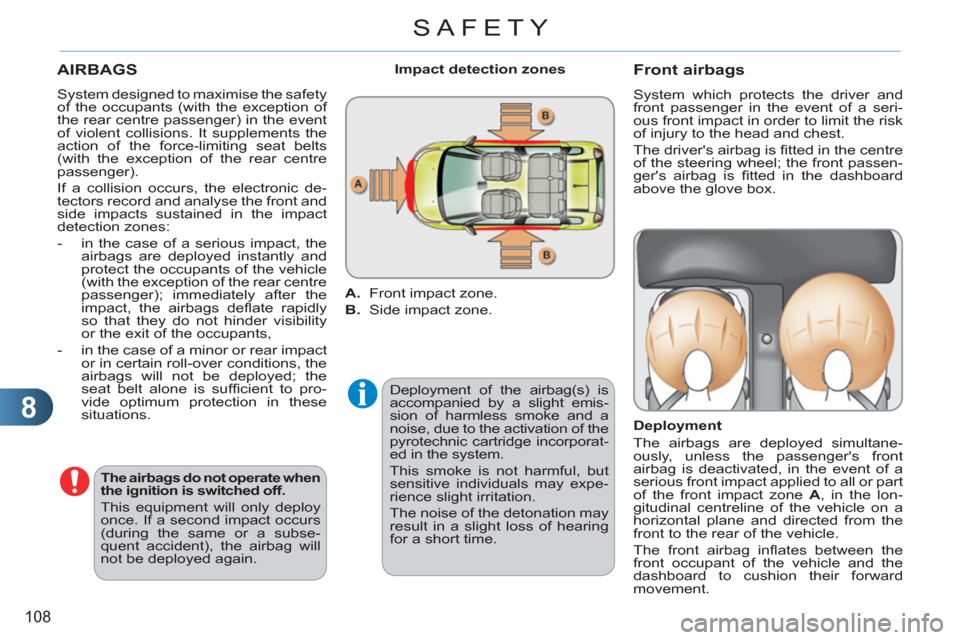
8
108
SAFETY
AIRBAGS
Deployment of the airbag(s) is
accompanied by a slight emis-
sion of harmless smoke and a
noise, due to the activation of the
pyrotechnic cartridge incorporat-
ed in the system.
This smoke is not harmful, but
sensitive individuals may expe-
rience slight irritation.
The noise of the detonation may
result in a slight loss of hearing
for a short time.
Front airbags
System which protects the driver and
front passenger in the event of a seri-
ous front impact in order to limit the risk
of injury to the head and chest.
The driver's airbag is fi tted in the centre
of the steering wheel; the front passen-
ger's airbag is fi tted in the dashboard
above the glove box.
Deployment
The airbags are deployed simultane-
ously, unless the passenger's front
airbag is deactivated, in the event of a
serious front impact applied to all or part
of the front impact zone A
, in the lon-
gitudinal centreline of the vehicle on a
horizontal plane and directed from the
front to the rear of the vehicle.
The front airbag infl ates between the
front occupant of the vehicle and the
dashboard to cushion their forward
movement.
Impact detection zones
A.
Front impact zone.
B.
Side impact zone.
The airbags do not operate when
the ignition is switched off.
This equipment will only deploy
once. If a second impact occurs
(during the same or a subse-
quent accident), the airbag will
not be deployed again.
System designed to maximise the safety
of the occupants (with the exception of
the rear centre passenger) in the event
of violent collisions. It supplements the
action of the force-limiting seat belts
(with the exception of the rear centre
passenger).
If a collision occurs, the electronic de-
tectors record and analyse the front and
side impacts sustained in the impact
detection zones:
- in the case of a serious impact, the
airbags are deployed instantly and
protect the occupants of the vehicle
(with the exception of the rear centre
passenger); immediately after the
impact, the airbags defl ate rapidly
so that they do not hinder visibility
or the exit of the occupants,
- in the case of a minor or rear impact
or in certain roll-over conditions, the
airbags will not be deployed; the
seat belt alone is suffi cient to pro-
vide optimum protection in these
situations.